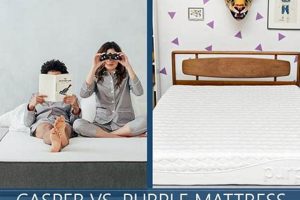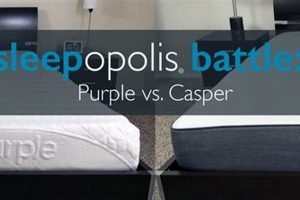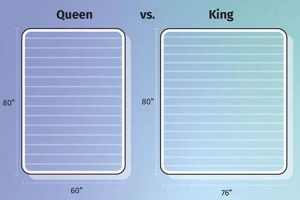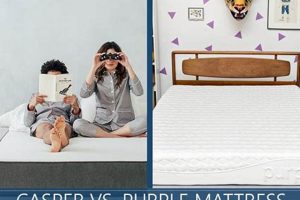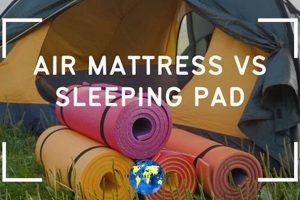The selection of a mattress often involves evaluating different foam types, specifically those incorporating either gel or traditional visco-elastic materials. These mattresses aim to provide support and pressure relief for improved sleep quality. The key difference lies in the composition and properties of the foam itself and its impact on temperature regulation.
The adoption of these materials in mattresses has grown significantly, driven by the demand for enhanced comfort and therapeutic benefits. Historically, advancements in polymer technology have paved the way for the development of foams with varying densities, responsiveness, and cooling capabilities. Consumers seek mattresses that alleviate pressure points, minimize motion transfer, and maintain a comfortable sleeping temperature throughout the night.
The following sections will delve into the characteristics of each material type, exploring their respective advantages and disadvantages in terms of comfort, support, durability, and thermal performance, providing a detailed comparison to aid in informed decision-making.
Guidance for Discriminating Mattress Selection
The process of selecting a suitable mattress requires careful consideration of individual needs and preferences. Evaluating the properties of different foam types is crucial for achieving optimal sleep quality and addressing specific concerns.
Tip 1: Prioritize Personal Sleep Preferences: Determine individual needs regarding firmness, support, and temperature regulation. Back sleepers may benefit from firmer support, while side sleepers often prefer a softer surface that contours to the body.
Tip 2: Evaluate Density and Support: Higher density foams typically offer greater support and durability. Consider the individual’s weight and sleeping position when assessing the appropriate density level.
Tip 3: Consider Thermal Regulation Properties: Individuals prone to overheating should prioritize mattresses with enhanced airflow or cooling technologies. Open-cell structures and infused materials, like gel, can contribute to improved temperature regulation.
Tip 4: Research Motion Isolation Capabilities: Couples may benefit from mattresses with excellent motion isolation to minimize disturbance from partner movement during sleep.
Tip 5: Investigate Certifications and Material Composition: Look for certifications from reputable organizations to ensure the mattress meets safety and quality standards. Pay attention to the materials used in construction, avoiding potentially harmful chemicals or allergens.
Tip 6: Assess Warranty and Return Policies: A comprehensive warranty and a generous return policy provide assurance and allow for a trial period to determine suitability.
Selecting a mattress involves a deliberate assessment of individual requirements and material characteristics. By considering these factors, individuals can make a more informed decision, leading to improved sleep and overall well-being.
The subsequent section will provide concluding remarks, synthesizing the key aspects of mattress selection and emphasizing the importance of aligning mattress choice with personal needs.
1. Temperature Regulation
Temperature regulation is a critical factor in mattress selection, directly influencing sleep comfort. The ability of a mattress to dissipate heat and maintain a stable sleeping surface temperature is a key differentiator between foam types.
- Gel Infusion Technology
The incorporation of gel particles into foam aims to enhance thermal conductivity. Gel-infused materials are designed to absorb and dissipate heat more effectively than traditional visco-elastic foams. This technology reduces heat buildup and promotes a cooler sleeping environment.
- Open-Cell Structure
Open-cell foam structures facilitate airflow within the mattress. This increased airflow allows for greater heat dissipation and ventilation, contributing to temperature regulation. Mattresses with denser, closed-cell structures often exhibit higher heat retention.
- Phase Change Materials
Phase change materials (PCMs) are sometimes integrated into mattress construction to regulate temperature. These materials absorb and release heat as they transition between solid and liquid states. PCMs help to maintain a consistent temperature by moderating fluctuations in the surrounding environment.
- Material Density and Airflow
The density of the foam directly impacts its ability to regulate temperature. Higher density foams tend to retain more heat, while lower density foams with increased airflow characteristics generally provide better temperature regulation.
Variations in temperature regulation capabilities significantly affect sleep quality. Selection should consider individual thermoregulation needs, as some individuals are more sensitive to temperature fluctuations during sleep. A mattress with effective temperature regulation contributes to a more restful and undisturbed sleep experience, mitigating overheating and promoting consistent comfort throughout the night.
2. Density Variation
Density variation is a critical attribute impacting the performance and feel of mattresses. The density of the foam core is particularly relevant when distinguishing between different mattress types, influencing durability, support, and overall comfort levels.
- Influence on Support and Firmness
Foam density directly correlates with the level of support a mattress provides. Higher density materials offer greater resistance to compression, leading to a firmer feel and enhanced support, particularly beneficial for individuals requiring spinal alignment or those of heavier build. Lower density foams, conversely, provide a softer, more conforming surface, suitable for those preferring a plush feel.
- Impact on Durability and Longevity
Higher density materials tend to exhibit greater durability and a longer lifespan. They are more resistant to wear and tear, maintaining their structural integrity and support characteristics over time. Lower density foams may degrade more quickly with regular use, leading to sagging or loss of support.
- Effect on Conformability and Pressure Relief
While higher density foams provide robust support, lower density options often excel in conformability. These foams readily adapt to the body’s contours, distributing weight evenly and alleviating pressure points. Hybrid designs often combine varying densities to achieve a balance between support and pressure relief.
- Relationship to Heat Retention and Airflow
Density affects the mattress’s thermal properties. Denser foams typically restrict airflow, leading to increased heat retention. Lower density foams, especially those with open-cell structures, allow for better ventilation and heat dissipation, promoting a cooler sleeping environment.
In summary, the density of mattress foam plays a pivotal role in determining its key characteristics. Selecting the appropriate density involves carefully balancing support requirements, comfort preferences, and thermal considerations to optimize the sleep experience. Variations in density are frequently employed to tailor mattress performance characteristics.
3. Pressure Relief
Effective pressure relief is a primary objective in mattress design, aimed at minimizing stress on specific areas of the body during sleep. The materials used in mattress construction significantly impact this ability, creating distinctions between various foam types in terms of comfort and therapeutic benefit.
- Conformability and Body Contouring
Mattresses designed for pressure relief excel in conforming to the body’s unique contours. This adaptation distributes weight more evenly across the sleeping surface, reducing concentrated pressure points, particularly in areas such as the shoulders, hips, and knees. Visco-elastic materials exhibit pronounced conformability, but variations exist based on density and composition.
- Role of Density and Firmness
Density influences a mattress’s ability to both support and relieve pressure. While higher density foams provide enhanced support, medium to lower density options often offer superior pressure relief due to their increased responsiveness to body weight. A balance between support and conformability is essential for optimal pressure distribution.
- Impact of Gel Infusion
The incorporation of gel into foam aims to enhance pressure relief properties. Gel particles may contribute to increased conformability and improved weight distribution. Furthermore, the cooling properties of gel can minimize localized heat build-up, which can exacerbate pressure-related discomfort.
- Effects on Spinal Alignment
Effective pressure relief contributes to improved spinal alignment during sleep. By minimizing pressure points, the spine is allowed to maintain a more natural curvature, reducing strain on muscles and ligaments. Mattresses that fail to provide adequate pressure relief can lead to misalignment and subsequent discomfort.
Pressure relief characteristics vary significantly between different foam compositions. Understanding these nuances is essential for selecting a mattress that effectively addresses individual needs, promoting comfortable and restorative sleep. Mattress selection should align with individual preferences and requirements for optimal pressure distribution and spinal support.
4. Motion Isolation
Motion isolation, a significant factor in mattress selection, refers to the ability of a mattress to minimize the transfer of movement from one area of the bed to another. This characteristic is particularly important for couples, as it reduces the likelihood of sleep disruption caused by a partner’s tossing and turning. Foams, both gel-infused and traditional visco-elastic, are generally superior in motion isolation compared to innerspring mattresses due to their ability to absorb energy rather than transmit it across the surface. For example, a person getting out of bed on one side of a mattress composed of these materials will generate less disturbance on the other side, compared to a conventional spring mattress.
The effectiveness of motion isolation is influenced by the density and composition of the foam layers. Higher-density foams generally offer better motion isolation, preventing the spread of movement more effectively. Gel-infused foams may provide a slight advantage in this regard due to their viscoelastic properties, which help dampen vibrations. Consider a scenario where one partner experiences restless leg syndrome; a mattress with good motion isolation can significantly mitigate the impact on the other partner’s sleep. The practical significance lies in improved sleep quality and reduced irritability for both individuals.
In summary, motion isolation is a critical performance characteristic of mattresses, particularly beneficial for shared beds. While both gel-infused and standard foams inherently provide better motion isolation than traditional spring mattresses, density and specific foam composition further refine this attribute. The understanding and prioritization of motion isolation contribute significantly to a more restful and undisturbed sleep experience.
5. Conformability
Conformability, in the context of mattresses, describes the extent to which the material adapts to the body’s shape. This attribute directly influences pressure distribution and spinal alignment, both key determinants of sleep comfort. Within foam types, variations in conformability exist due to differences in density, composition, and construction techniques. Mattresses with superior conformability reduce pressure points, leading to decreased tossing and turning, and promoting a more restful sleep cycle. Consider, for instance, a side sleeper. A mattress with excellent conformability will cradle the shoulder and hip, preventing pressure buildup that can cause discomfort and awakenings.
Gel-infused foams and traditional visco-elastic materials exhibit distinct conformability characteristics. While both conform to the body, gel-infused options may offer a slight advantage in heat dissipation, potentially mitigating heat build-up in areas of high contact. This can further enhance comfort and reduce sleep disruptions. The degree to which a mattress conforms is a function of its composition and how it interacts with body weight and temperature. Evaluating specific conformability levels requires objective testing and user feedback, as subjective perceptions can vary.
Ultimately, the desired level of conformability is a matter of personal preference and individual needs. Factors such as body weight, sleeping position, and any pre-existing musculoskeletal conditions should inform the selection process. A mattress that effectively conforms to the body provides optimal support and pressure relief, facilitating proper spinal alignment and contributing to improved sleep quality and overall well-being. Neglecting conformability considerations may result in discomfort, pain, and compromised sleep.
6. Cost Differential
The cost differential between gel-infused and traditional visco-elastic mattresses arises from variations in manufacturing processes and material composition. Gel infusion, an added step in production, increases material costs. Furthermore, the specific type and concentration of gel used impact the final retail price. The higher cost is often justified by manufacturers through purported improvements in temperature regulation and enhanced comfort. However, the actual impact on sleep quality can vary considerably among individuals.
The cost differential also reflects brand positioning and marketing strategies. Mattresses incorporating gel are often marketed as premium products, contributing to a perception of higher value. While some consumers are willing to pay a premium for these features, objective evidence supporting the claimed benefits may not always be conclusive. Variations in foam density, construction techniques, and certifications further contribute to price discrepancies. It is important to note that cost is not always directly proportional to quality or suitability.
In summary, the cost differential represents a complex interplay of manufacturing costs, marketing strategies, and perceived value. While gel-infused mattresses generally command a higher price, careful evaluation of individual needs and a comparison of specifications are essential to ensure that the additional expense translates into tangible benefits and improved sleep outcomes. The optimal choice depends not solely on cost, but on aligning material properties with individual comfort preferences and sleep requirements.
Frequently Asked Questions
This section addresses common inquiries regarding differences in mattresses, specifically focusing on materials and their properties. Information provided aims to offer clarification on selection considerations.
Question 1: What defines the primary distinction between gel-infused and traditional visco-elastic mattresses?
The principal distinction lies in temperature regulation. Gel-infused mattresses incorporate materials intended to dissipate heat more effectively than conventional visco-elastic foams, which tend to retain heat.
Question 2: Does gel infusion guarantee superior temperature control during sleep?
While gel infusion is designed to enhance thermal conductivity, its effectiveness varies. Mattress construction, ventilation, and individual thermoregulation contribute to overall temperature control.
Question 3: How does foam density influence mattress support and durability?
Higher density foams generally provide greater support and durability. These materials resist compression and maintain their structural integrity over extended periods. Lower density foams may offer enhanced conformability but may degrade more rapidly.
Question 4: Does motion isolation depend solely on the type of foam used?
Motion isolation is influenced by foam density and mattress construction. Higher density foams typically provide better motion isolation, minimizing the transfer of movement across the sleeping surface. Mattress design also plays a role.
Question 5: Does a higher price point necessarily equate to superior mattress quality?
A higher price does not guarantee superior quality. Price often reflects brand positioning, materials, and construction techniques. Evaluate mattress specifications and certifications to assess value.
Question 6: How should individual sleeping positions influence mattress selection?
Sleeping position significantly affects mattress selection. Side sleepers typically require greater conformability and pressure relief, while back sleepers may benefit from firmer support. Consider individual needs when selecting a mattress.
Key takeaways include the importance of considering individual preferences, evaluating material properties, and aligning mattress selection with specific sleep requirements. Further research and objective testing contribute to informed decision-making.
The next section will delve into additional resources and considerations for long-term mattress care.
gel foam mattress vs memory foam
This exploration has presented a detailed analysis of materials. Differentiation arises from temperature regulation, density variation, pressure relief, motion isolation, and conformability. Cost differentials often reflect manufacturing processes and marketing strategies. An understanding of these factors is crucial for informed purchasing.
Prospective buyers should consider individual needs, preferences, and objective mattress specifications. Strategic assessment ensures the selection of a mattress that promotes optimal sleep quality and long-term satisfaction. The information detailed should enable consumers to confidently approach selecting and maintaining their choice.


